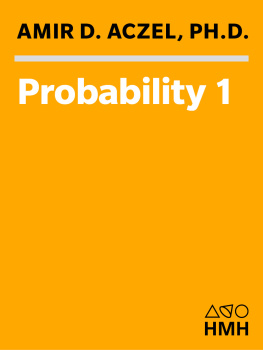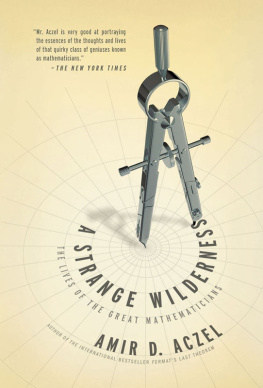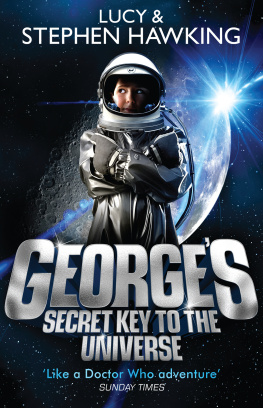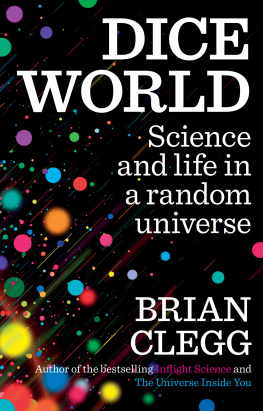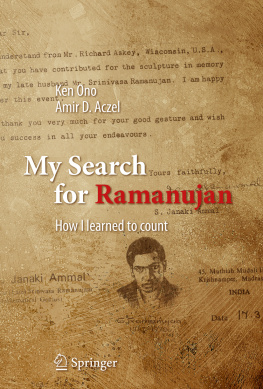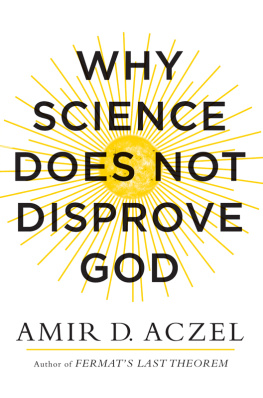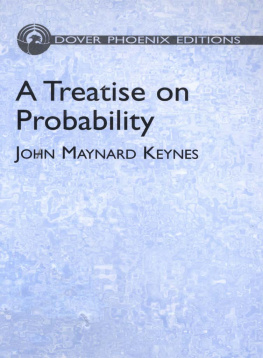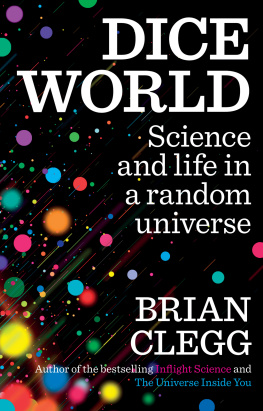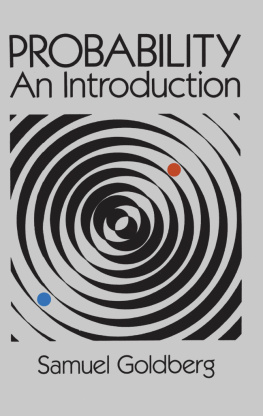Copyright 1998 by Amir D. Aczel
All rights reserved. No part of this publication may be reproduced or transmitted in any form or by any means, electronic or mechanical, including photocopy, recording, or any information storage and retrieval system, without permission in writing from the publisher.
For information about permission to reproduce selections from this book, write to Permissions, Houghton Mifflin Harcourt Publishing Company, 215 Park Avenue South, New York, New York 10003.
www.hmhco.com
The Library of Congress has cataloged the print edition as follows:
Aczel, Amir D.
Probability 1/Amir D. Aczel.
p. cm.
Includes bibliographical references and index.
ISBN 0-15-100376-9
ISBN 0-15-601080-1 (pbk.)
1. Life on other planets. 2. Cosmology. 3. Mathematics. 4. Biology.
I. Title.
QB 54. A 25 1998
576.8'39dc21 98-16868
e ISBN 978-0-544-34166-1
v1.0614
For Debra
Authors Note
S INCE THE ORIGINAL publication of Probability 1 in 1998, exciting developments have been made in our search for extraterrestrial life. This year, two independent teams of scientists from San Francisco State University and the Harvard-Smithsonian Center for Astrophysics announced their discovery of three large planets around Upsilon Andromedae, a solar-type star 44 light-years away. This discovery marked the first clear evidence of another star similar to our sun, one accompanied by multiple planets in a stable system. Not only did this prove that other solar systems like ours exist, it also heightened the probability of other habitable planets in galaxies far away.
In addition to the discovery of solar systems, numerous advances in the field of science have improved our understanding of how life began on Earth. Chief among these advances is that we know that life on Earth began over 2.7 billion years ago, much longer than previously thought. In relative terms, life on our planet began very shortly after the atmosphere stabilized. It is likely, therefore, that once conditions are right anywhere in the universe, life can begin.
Preface
O N THE EVENING OF February 26, 1998, I was standing on a beach in Aruba with a group of astronomers. Earlier that afternoon, between 2:11 and 2:14 P.M. , we had watched the day turn into night as a total solar eclipse passed over the island. We were all still excited from the awesome event we had witnessed only a few hours earlier, and we were now looking at stars and galaxies and a nebula that remained in the sky from a giant supernova explosion witnessed by the Chinese a thousand years ago. As we were talking animatedly about these mysterious objects of the night sky, standing around the large telescope, some of the vacationers at the resortwho had not come here to witness an eclipse or view the starscame over out of curiosity. After a few moments, one of them moved closer to the telescope and asked Daryl, the astronomer, if she could look through it. He was thrilled to comply and offered to show her and her companion a double star system or a nebula or a beautiful cluster of fifty brilliant red and blue stars called the Jewel Box. No, no, she said, waving her hand and smiling. Could you maybe show us some planets... with life on them?
I walked away down the sand. The quest for life outside Earth seemed more intense now as we approach the third millennium. The womans wish to see planets with life only served to emphasize this point, which has been made in newspapers and science magazines and televisionnot to mention announcements from NASA about the findings from the Galileo spacecraft, which may have detected evidence for liquid water under the ice cover of Jupiters moon Europa. Could we finally be on the verge of discovering extraterrestrial life? All this speculation was very exciting for me. I had just finished the manuscript of a book about the probability that life exists on some distant planet in orbit around a star not too different from the Sunour own star, whose magnificence I now appreciated more than ever, having seen it disappear as by magic behind the Moon and reappear on the other side. Now standing under the bright winter stars, I was thinking about how this adventure started for me.
Just before Labor Day in 1997, I called Jane Isay, executive editor at Harcourt Brace in New York, to ask her if she would be interested in publishing my next book. I had lots of ideas, but Jane liked none of them. So we talked about many other subjects: mathematics and science and probability. And then Jane asked: How would you like to write a book about the probability of life in outer space? and she proceeded to tell me how Carl Sagan had wanted to write a book about this topic but for some reason it never materialized, and he passed away. These are big shoes to step into, I remember saying. Just try, she answered. I was intrigued.
For a long time, researching this book, I was skeptical. And as I considered the science involved: chemistry and DNA and biology and geology and physics and astronomy, the prospects did not look any more promising.
Then, almost at the last minute, I turned my attention to probability theory. And here, something happened that surprised me. Probability is not an intuitive area. Often, people think they have an answer, but mathematically it does not hold, and something else proves to be true. Mathematics is the key to probability theory, and the math always winssometimes despite our intuition. And the mathematics and probability theory always pointed in one direction: the probability of life in outer space is one, just as Carl Sagan had believed. This book will take you through my journey of discovery leading to this conclusion.
M ANY PEOPLE HAVE contributed to my research for this book, and it would be difficult to acknowledge all of them here, so I will mention the ones to whom I owe the greatest debt of gratitude. I thank my editor and friend Jane Isay for her vision, encouragement, support, and her trust in me throughout this difficult project. I thank Lorie Stoopack of Harcourt Brace for her superb editing and generous help with the manuscript. I thank Jennifer Mueller of Harcourt Brace. I thank Erin DeWitt for her excellent copyediting. I thank Dr. Michel Mayor of the Geneva Observatory, a great astronomer and a wonderful human being, for his generous help and intriguing conversations. I thank Dr. Philip Morrison of MIT and Dr. Frank Drake of the University of California at Santa Cruz, founder of the SETI project, for informative interviews. For his views and comments, I thank Robert Naeye, associate editor of Astronomya magazine I highly recommend to anyone interested in the subject. I thank Professors Marilyn Durkin and Norman Josephy of Bentley College for computergenerated fractals, and astronomer Stephen Mock for various observations. Finally, I thank my wife, Debra, for many suggestions on the manuscript.
Fermis Paradox and Drakes Equation
There are infinite worlds both like and unlike this world of ours. For the atoms being infinite in number are borne far out into space. For those atoms have not been used up either on one world or on a limited number of worlds, not on all of the worlds which are alike, or on those which are different from these. So that there nowhere exists an obstacle to the infinite number of worlds. We must believe that in all worlds there are living creatures and plants and other things we see in this world.
Thus wrote Epicurus (341270 B.C. ) twenty-three hundred years ago. He had developed some of the ideas about extraterrestrial life put forward by the Greek philosophers Democritus and Leucippus, who lived two centuries earlier. Epicurus put down these thoughts about extraterrestrial life in a letter he wrote to Herodotus.
For the ancient Greek philosophers, the worlds referred to here were not planets orbiting stars. The stars were considered part of the firmament of the heaven and were seen to orbit Earth at no greater a distance than those of the planets of our solar system. The other worlds were viewed as replications of Earth that could not be seen by observing the sky.
Next page
